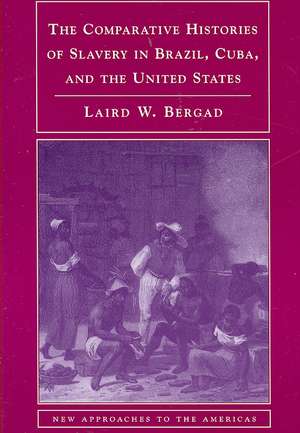The Comparative Histories of Slavery in Brazil, Cuba, and the United States: New Approaches to the Americas
Autor Laird Bergaden Limba Engleză Paperback – 24 iun 2007
| Toate formatele și edițiile | Preț | Express |
|---|---|---|
| Paperback (1) | 201.23 lei 3-5 săpt. | |
| Cambridge University Press – 24 iun 2007 | 201.23 lei 3-5 săpt. | |
| Hardback (1) | 556.91 lei 6-8 săpt. | |
| Cambridge University Press – 24 iun 2007 | 556.91 lei 6-8 săpt. |
Preț: 201.23 lei
Nou
Puncte Express: 302
Preț estimativ în valută:
38.52€ • 40.20$ • 32.29£
38.52€ • 40.20$ • 32.29£
Carte disponibilă
Livrare economică 19 februarie-05 martie
Preluare comenzi: 021 569.72.76
Specificații
ISBN-13: 9780521694100
ISBN-10: 0521694108
Pagini: 342
Ilustrații: 5 tables
Dimensiuni: 152 x 226 x 20 mm
Greutate: 0.5 kg
Editura: Cambridge University Press
Colecția Cambridge University Press
Seria New Approaches to the Americas
Locul publicării:New York, United States
ISBN-10: 0521694108
Pagini: 342
Ilustrații: 5 tables
Dimensiuni: 152 x 226 x 20 mm
Greutate: 0.5 kg
Editura: Cambridge University Press
Colecția Cambridge University Press
Seria New Approaches to the Americas
Locul publicării:New York, United States
Cuprins
Introduction; 1. From colonization to abolition: patterns of historical development in Brazil, Cuba, and the United States; 2. The diversity of slavery in the Americas to 1790; 3. Slaves in their own words; 4. Slave populations; 5. Economic aspects; 6. Making space; 7. Resistance and rebellions; 8. Abolition; Bibliography.
Recenzii
"...Bergad's stated purpose is to integrate new interdisciplinary knowledge about three major slave societies-Cuba, Brazil, and the United States (why not Puerto Rico?)-in a digestible form for advanced undergraduates, graduate students, and the general public....provide a clear view of profitability and technology of slavery....In textbook format, Bergad provides an effective overview of colonization and the rise of slavery as the primary system of production for each of his areas of study-North America (United States), Cuba, and Brazil, with some discussion of other parts of the Americas....The presentation of data regarding production, prices, investments, and demography...makes for an admirable introduction to the economics of slavery...."
--Paul E. Lovejoy, York University, Journal of Interdisciplinary History
"...should be required reading in any course on nineteenth century U.S. or Latin American History." -David Eltis, EH.NET
"...a welcome addition to textbooks on slavery in the Americas." -Jacob M. Blosser, World History Bulletin
"For those accustomed to the study of the 'birth of African American culture' solely from the perspective of the Anglo-Dutch Atlantic, this book has much to offer." -Jorge Canizares-Esguerra, Journal of American Ethnic History
--Paul E. Lovejoy, York University, Journal of Interdisciplinary History
"...should be required reading in any course on nineteenth century U.S. or Latin American History." -David Eltis, EH.NET
"...a welcome addition to textbooks on slavery in the Americas." -Jacob M. Blosser, World History Bulletin
"For those accustomed to the study of the 'birth of African American culture' solely from the perspective of the Anglo-Dutch Atlantic, this book has much to offer." -Jorge Canizares-Esguerra, Journal of American Ethnic History
Notă biografică
Descriere
This 2007 book is an introductory history of racial slavery in the Americas.

































